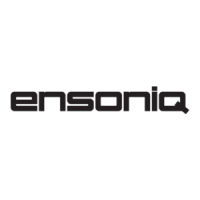Chapter 8—Insert Effect Parameters
To access the Parameters described on this page (unless otherwise noted):
Press Effects, turn the Parameter knob to select Insert Effect, and press Enter. Turn the Parameter
knob to select the parameter, and use the Value knob to change the parameter's Setting.
ENSONIQ MR-Rack Musician’s Manual 5
03 Large Room
04 Small Room
H
a
ll
R
e
v
e
r
b
i
s
a
l
a
r
g
e
a
c
o
u
s
t
i
c
s
p
a
ce
,
a
n
d
p
r
o
v
i
d
e
s
a
h
i
g
h
d
e
n
s
i
t
y
r
e
v
e
r
b
.
L
a
r
g
e
R
oo
m
r
e
v
e
r
b
p
r
o
v
i
d
e
s
a
m
b
i
e
n
ce
,
a
n
d
S
m
a
ll
R
oo
m
r
e
v
e
r
b
s
i
m
u
l
a
t
e
s
t
h
e
a
m
b
i
e
n
ce
o
f
a
s
m
a
ll
r
oo
m
.
Parameter Range Description
Decay 0sec to 12.7sec
(Hall setting)
0sec to 10.0sec
(Room settings)
Controls the amount of time it takes for the reverberation to decay to a
very low level after the input signal stops. Higher values are
recommended for the hall reverb.
LF Decay -99% to +99% Functions as a tone control and boosts (when set to a positive value) or
cuts (when set to a negative value) the rate at which low frequencies will
decay.
HF Damping 100Hz to 21.2kHz Controls the rate of attenuation of high frequencies in the decay of the
reverberation. As natural reverb decays, some high frequencies tend to
get absorbed by the environment. Increasing the value of this parameter
will gradually filter out (dampen) more and more high frequency energy.
HF Bandwidth 100Hz to 21.2kHz The high frequency bandwidth acts as a low pass filter on the signal
going into the reverb, controlling the amount of high frequencies that will
pass into the effect. The higher the setting, the more high frequencies are
allowed to pass.
Primary Send -99% to +99% Controls the level of the diffused input signal into the reverb definition.
Diffusion 1 0 to 100 Smears the input signal transients, to diffuse and smooth the sound.
Lower values will cause impulse sounds to appear as a series of discrete
echoes, while higher values tend to increase the smear (smoother
sounding with fewer discrete echoes). We recommend settings of 50 for
starters.
Diffusion 2 0 to 100 This parameter, similar to and in series with Diffusion1, performs the
same way but controls lower frequency ranges. Experiment with different
levels between the diffusion parameters to find the settings that are right
for your source.
Definition 0 to 100 Controls the rate at which echo density is increased with time. Setting
this parameter too high can cause the echo density to build at a rate which
exceeds the decay rate. A general rule of thumb is this: Definition should
not exceed the LF Decay time added to the Decay time.
Detune Rate 0.00Hz to 1.54Hz Controls the LFO rate of detuning introduced into the reverberation
decay. Detuning creates a slight oscillating pitch shift into the decay,
giving it a more natural sound by breaking up resonant modes.
Detune Depth 0% to 100% Controls the depth of the detuning, that is, how much the pitch will
change. Low values yield a metallic sound. Some sounds may require
very low values, while others sound more natural with higher values.
PreDelay 0 to 36ms Controls the amount of time it takes for the original signal to be
presented to the reverb. Higher values denote a longer delay.
ER 1 Time 0 to 112ms Controls the delay time for the first pre-echo. Pre-echoes are the first
sounds reflected back from the walls or reflective “live” surfaces. Higher
values delay the diffused signal more.
ER 1 Send -99% to +99% Controls the level of the first pre-echo, with the echo routed directly to
the output.
ER 1 Level -99% to +99% Controls the level of the first pre-echo. This pre-level controls the echo
send to the Definition.
ER 2 Time 0 to 112ms Controls the delay time for the second pre-echo.
ER 2 Send -99% to +99% Controls the level of the second pre-echo, with the echo routed directly to
the output.
ER 2 Level -99% to +99% Controls the level of the second pre-echo. As a signal continues to
bounce off the different reflective surfaces (walls), it decreases in
volume. Set this parameter to a lower value than Ref 1 Level, in order to
create a natural sounding echo.

